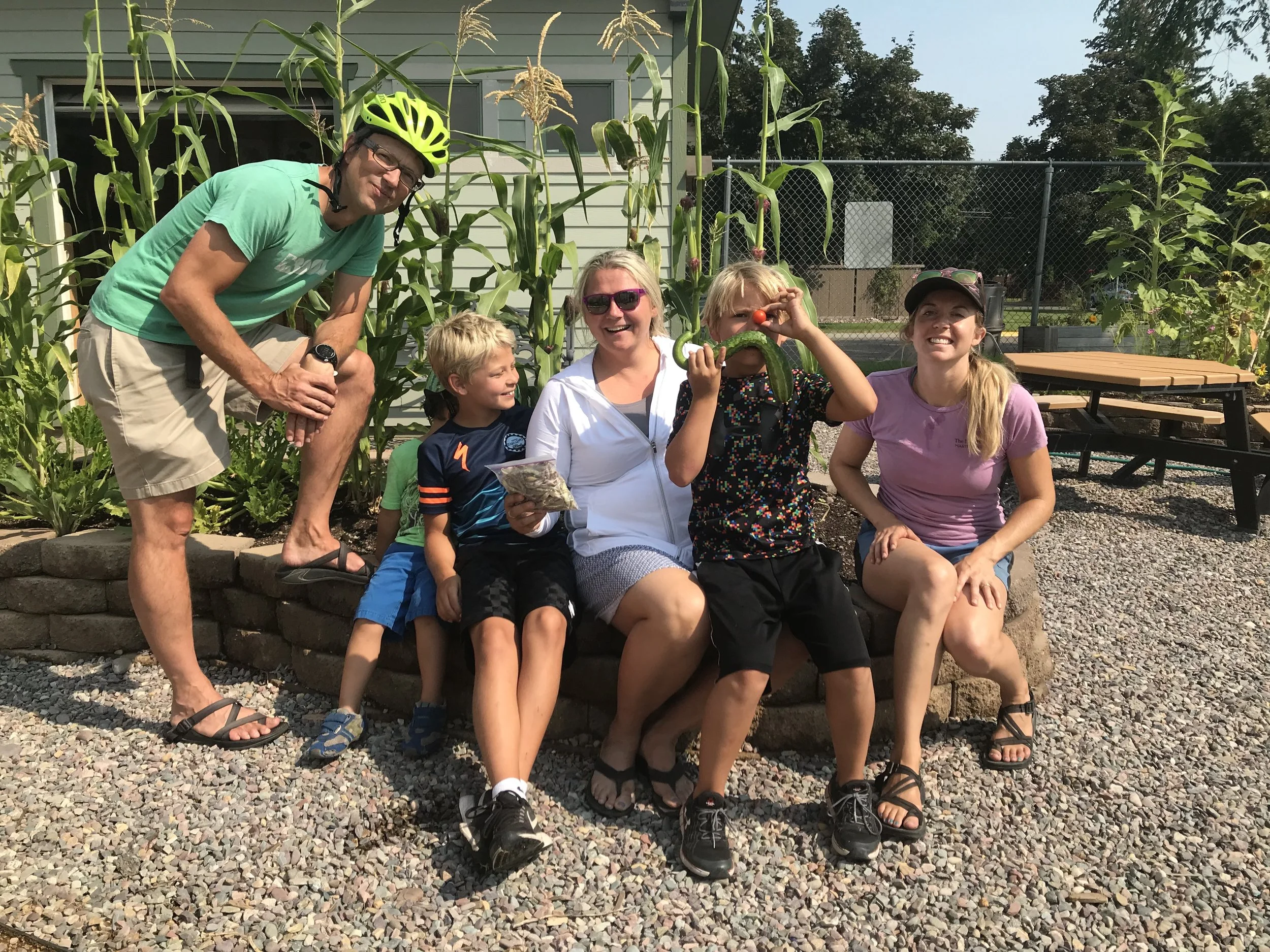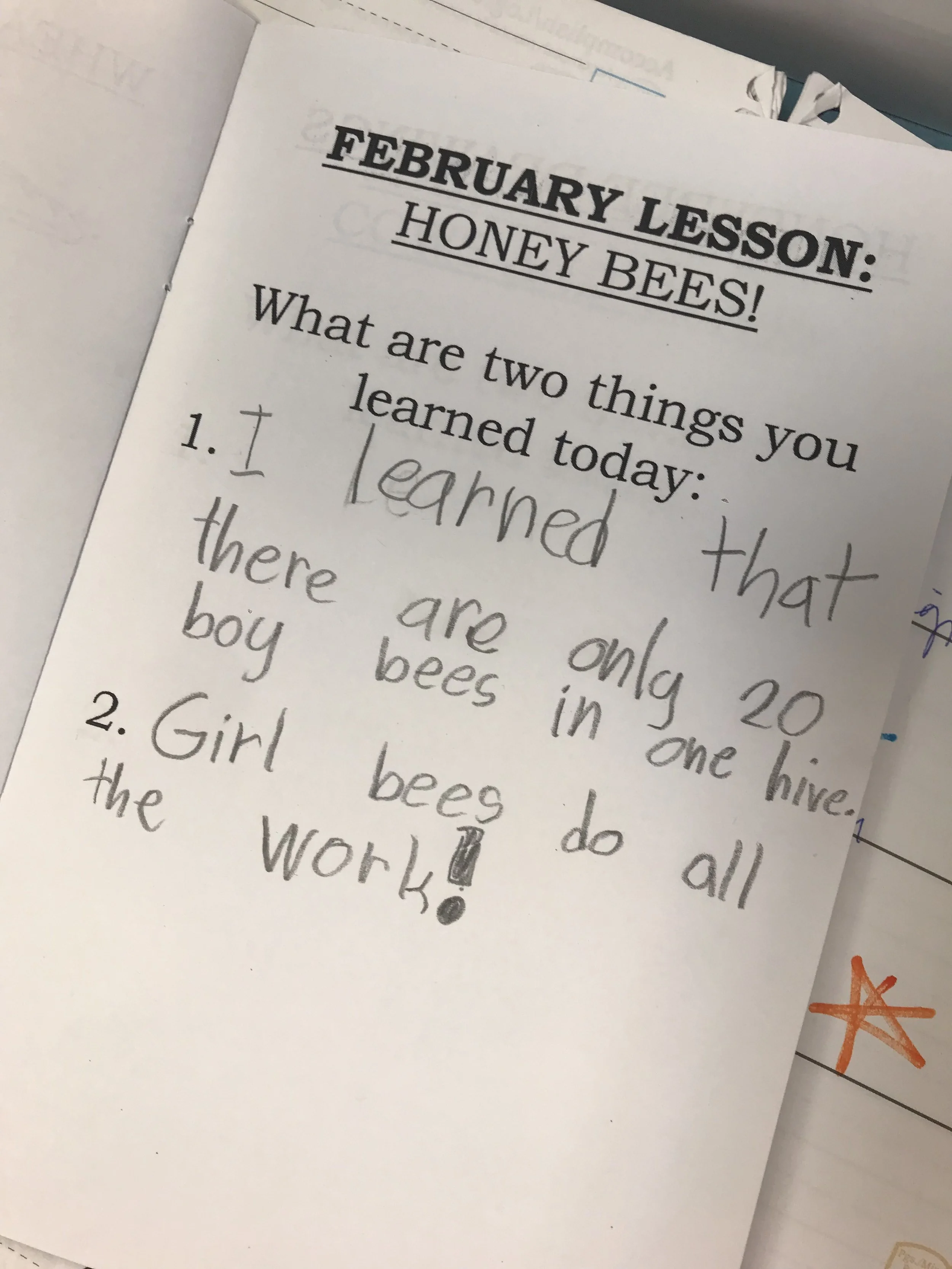Honey Bees, Cows, and Montana Super-Bread: Reflecting on Farmer in the Classroom
Here’s a post from Lori Blumenthal, one of our School Garden Managers here at Garden City Harvest. This is the first time ever that our famous Montana Super-Bread recipe is revealed, too! Read on. . .
Lori with the Leeds-Knight family last season with some delicious veggies grown in the school garden.
I teach Farmer in the Classroom as one of the School Garden Managers here at Garden City Harvest. A few weeks ago, I received a heart-warming email from a parent of a second grade student at Paxson Elementary School. While teachers and kiddos are generally happy to have me visiting their classrooms (“YAYYY, Farmer Lori’s here!”), it’s not often that I get feedback from families. This email made me realize once again why what we do here in Farm to School at Garden City Harvest is important:
Hey Lori,
I hope all is fabulous! Plum was so excited you came to school today (Mrs. Manning’s second grade at Paxson). She told me all about bees, the queen, the workers, that there are “like 120 bees in a hive.” She talked the entire walk home about it. We are going to the library this weekend to get some books on bees and do more research. She loves every time you visit.
Thank you,
Elizabeth Stuckey
PS the honey was a big hit too :)
A note from one of the student’s Farmer in the Classroom journals. Lessons draw on writing, math, science, writing, and more.
Farmer in the Classroom is a year long program offered for second graders in Missoula County Public Schools. From November to April, we make monthly visits to each classroom and teach a range of topics that educate kids about Montana agriculture, nutrition, and how the food choices we make impact our planet.
To make this information even more relatable to young minds, this program is capped in the Spring and Fall with a field trip to the PEAS Farm. PEAS is a working, sustainable urban educational farm (and magical place to learn) here in Missoula.
The PEAS field trips helps kiddos grasp some of the more intangible topics presented in Farmer in the Classroom:
Storage Veggies:
Yes! Onions really can last all winter long without going bad! When you get to see a real root cellar with veggies leftover from the fall harvest, you might be able to understand how, in the frontier days, Montanans might have gotten through a long winter when there wasn’t a grocery nearby. And, that many still do store onions all winter long.
Fruits:
Do you see any orange trees on the PEAS farm? There are lots of really tasty fruits growing right here in Montana. You’ll see apple trees, pear trees, plum trees, and more! I bet if you ask a second grader, they could tell you other ways to tell the difference between Montana fruits and tropical fruits…
Seeds:
Why do plants make seeds? This topic dovetails beautifully with second grade science curriculum, helping to reinforce big ideas like “cotyledon” and “embryo”. It also helps students think about simpler ideas like; anything with a seed inside is a fruit. This then invites arguments about whether or not a tomato is a fruit... ah, the age-old question.
Honey Bees and Wasps:
Is there any creature more fascinating than the honey bee? These cooperative creatures help kiddos think about how different species live lives very different than their own. This year, the PEAS bees worked very hard, and we were able to give taste tests of delicious PEAS honey to each second grader. I know that they’re looking forward to saying “thank you” to the bees during their Spring field trips to the farm.
The queen bee, a drawing in one second grader’s Farmer in the Classroom journal.
Cows and Grass:
Did you know there are 3,000,000 cows in Montana?! That’s about 3 cows for every person. I love showing second graders how big that number is, and how big of a deal cows are in our state. We have a lot of fun drawing the cows and grass cycle, talking about cow manure, and getting the chance to taste some “Mont-zarella” cheese from one of the remaining local family-owned dairy operations.
Looking back at the past six months, I’ve made lots of new second-grade friends. I’m looking forward to seeing them in their school gardens, and out in the town. During our April lessons, students had the chance to taste some “Montana Super Bread” which has an ingredient from each topic we’ve discussed. I want to share the recipe with you so that you can bring a little bit of Farmer in the Classroom home.
Diagram of grass: cow eats the grass, grass gets digested into manure (which means the kids get to say poop, their favorite!) and the manure gets spread on the fields to grow food and possibly more grass!
Montana Super Bread:
Ingredients:
1 cup squash/pumpkin puree
1/3 cup apple sauce
1/2 cup canola oil
1/4 cup water
½ cup shredded carrots
1/2 cup sugar or 1/3 cup honey
1/3 cup brown sugar
1 3/4 cups flour
1 teaspoons baking soda
1 teaspoon baking powder
1/2 teaspoon salt
1.5 teaspoons ground cinnamon
½ cup unsalted roasted sunflower seeds
Directions:
1. Preheat oven to 350 degrees F (175 degrees C). Grease and flour one 8.5 x 4.5 x 2.5 inch loaf pan.
2. In a large bowl, mix together the squash puree, apple sauce, oil, carrots, water and sugars until thoroughly combined. In a separate bowl, whisk together the flour, baking soda, baking powder, salt, and cinnamon.
3. Stir the dry ingredients into the wet ingredients. Combine just until incorporated then add the sunflower seeds and mix briefly; do not over mix. Pour into the prepared, greased pan.
4. Bake on center rack at 350 degrees for 55-65 minutes (or 45-55 minutes in a convection oven) or until a wooden skewer inserted into the center of the loaf comes out clean.




